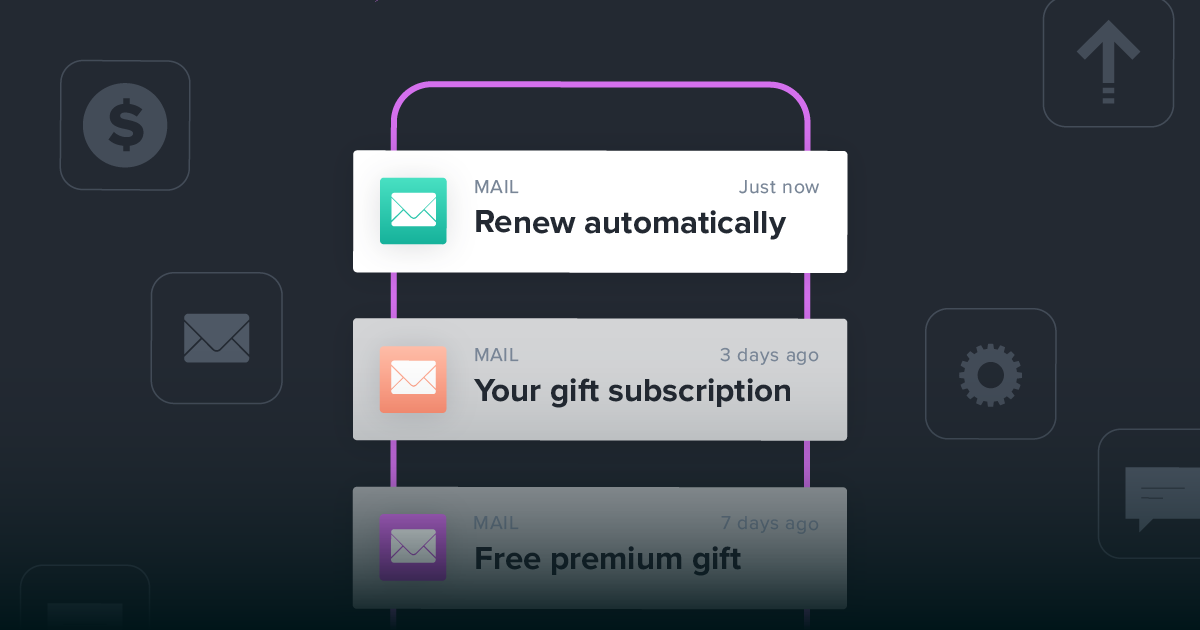Customer renewal rate guide: Best-practices to improve SaaS renewals

Recurring payments form the lifeblood of subscription commerce. Therefore, subscription renewals are critical to drive stable revenue growth and profitability. Any friction during renewals trickles down to the bottom line, making these journeys crucial. This article discusses some of the best practices to incorporate for a seamless subscription renewal journey.
What is SaaS renewal and how to calculate subscription renewal rates?
A subscription renewal is the process an existing customer undertakes to extend their subscription into the next billing cycle in order to keep using a software's features and services.There are two types of subscription renewals: manual renewals and automatic renewals.
Manual subscription renewals require customers to log in each time to renew and possibly update their card on file, address, or email address. Any interruptions in this–such as site crash, failure to process payment, or even a poor user experience or interface (UX/UI)–can annoy them and lead to involuntary churn.
Automatic subscription renewals don’t require customer intervention, and automatic payments are processed each time the renewal period is up, unless it is intentionally paused. An automated subscription renewal process relieves the extra efforts needed to renew. However, sometimes automated renewals lead to disappointed customers, or may violate consumer rights based on new legislation.
The renewal rate is a crucial metric that refers to the percentage of customers who renew their contracts at the end of a subscription period. Typically, good services businesses have renewal rates of 80%, while more sticky software renewal rates hit 90% or more.
To calculate subscription renewal rates, define the duration over which you want to calculate the renewal rate (monthly, quarterly, or annually), identify the total number of customers who had an active subscription at the beginning of the chosen period as well as those who continue their subscription at the end of the defined period, then divide the number of contract renewals by the number of recurring customers and multiply the result by 100 to get the renewal rate as a percentage.
Understanding why customers cancel subscriptions
There are a variety of reasons a customer may fail to renew their subscription. Involuntary churn can sneak up on your business, especially if your customer forgets to renew their subscription or their payment details have changed. On the other hand, some subscribers may no longer wish to use the product or service if it no longer benefits them.
Customer satisfaction
Customer satisfaction is crucial for any business as it directly affects customer loyalty and repeat purchases. A highly satisfied customer is more likely to become a loyal advocate for a brand, attracting more users through positive word-of-mouth from their customer feedback.
If a product is reliable, easy to use, and offers round-the-clock support, happy customers are more likely to renew their subscriptions. On the other hand, if a product is not reliable, is difficult to use, and offers minimal support, the customer may be likely to cancel their subscription.
Pricing strategies and tiers
Different pricing approaches can have varying impacts on customer relationships in the SaaS industry. Cost-plus pricing sets the price by adding a profit margin to the product or service's production cost, offering a sense of transparency to customers. Value-based pricing focuses on the perceived value of the product, reflecting what customers are willing to pay, which can enhance customer satisfaction if they believe they are receiving more value than the cost they are paying. Competitive pricing sets prices based on what other companies are charging for similar services, which can retain customers if the prices are competitive in the market.
To balance company objectives with customer financial health and needs, flexible pricing tiers should be implemented. By offering different pricing options with varying features and capabilities, customers can select a tier that aligns with their requirements and budget. If your pricing tiers are mismatched, customers may subscribe for a short period, then cancel if your service no longer matches their budget expectations.
Quality of services
Maintaining high service quality ensures that customers receive consistent and reliable performance. Innovative features are also increasingly important to meet changing customer needs and expectations. By introducing new features or enhancing existing ones, companies can offer value-added services to their customers, demonstrating a commitment to continuous improvement and innovation, making the service more appealing and competitive in the market. However, if a service is low-quality and poorly maintained, people are unlikely to return to using the service.
Why subscription renewals matter for SaaS businesses
If you are trying to grow a successful SaaS company, subscription renewals matter for you because they will ensure consistent profits. As your business grows, acquires new subscribers, and maintains their loyalty, you will be guaranteed profits at any point in the subscription period. Instead of hoping to make profits from a one-time payment, having a recurring revenue stream from subscribers will be profitable both in the long and short term.
With this in mind, keeping such a subscriber base is essential. If your customers involuntarily churn or if they choose to cancel their subscriptions, your business may bleed projected revenue. By having a subscription renewal journey that is easy to follow through with, your renewal rates can stay consistent, improving your company's health.
Renewal journeys for both manual or automatic billing types matter due to their contribution to revenue and growth goals. Statistically,
It costs five times more to acquire new customers than to retain existing ones. In other words, it makes better business sense to prioritize retention.
Research by Bain & Company suggests that a 5% increase in retention can translate into a 25% to 95% rise in profits.
According to Microsoft, 60% of consumers have stopped doing business with a brand due to poor customer service.
Clearly, a subscriber’s decision to renew, pause, or cancel subscriptions impacts the business fundamentals. Losing out on subscribers due to renewal friction is undesirable. Hence, optimizing the journey demands attention.
Effective renewal strategies for long-term subscription revenue
To effectively encourage customers to renew their subscriptions, your company should implement certain strategies and best-practices to improve customer retention and subscription-based revenue.
Enhance the customer experience with a seamless, high-quality service or product throughout the subscription time period. Streamline the registration process, simplify account management, and actively communicate with customers to address any concerns promptly.
Optimize customer engagement by offering exclusive content, early access to new product features, or discounts to remind them of the value they receive from your subscription and keep them interested in your brand.
Provide excellent customer service support that is fast and reliable and ensures prompt responses to any issues, via a 24-hour customer helpline, live chat, or prompt email support.
Offer trials or incentives that encourage potential customers to try out your subscription service before paying for it.
Provide ample renewal times, offer efficient quotes, and different payment options for flexible renewals to ensure credit card charges go through.
Offer click-to-cancel options, should your users wish to prevent dark patterns from trapping your users in your service.
Utilize customer cohorts data to gain insights into their preferences, behaviors, and usage patterns to tailor your services accordingly and elongate the customer lifetime.
Learn more about improving your subscription renewal rates.
Best-practices to ensure a frictionless subscription renewal journey
Most renewals follow a monthly, quarterly, or annual subscription billing cycle. Sometimes they may be longer depending on the nature or the type of contract terms. Regardless of the renewal cycle length, all renewal journeys are based on the same key elements, including:
Generating order records within the subscription platform to track the user’s subscription status.
Notifying customers about their upcoming subscription expiration.
Charging the customer through their preferred payment method.
Providing the product in case it’s a non-service subscription.
Marking the process as complete on the subscription billing platform.
A frictionless renewal journey ensures that each of these steps is conducted smoothly.
Achieving a seamless renewal process is easy for most business models if you get the basics right. Here are some best practices to integrate into your subscription renewal journey:
1. Standardize your SaaS subscription renewal process to make it painless with organized tracking and timely intimation
Standardizing your SaaS subscription renewal process is crucial to ensuring a painless experience for your customers and optimizing renewal rates. By standardizing the renewal process, you can streamline operations, reduce customer frustration, and improve overall satisfaction.
A painless customer renewal process starts with clear communication and transparency. It’s important to provide ample time for all customers to renew their subscriptions. Sending out reminders too close to the expiration date can result in involuntary churn. For renewals, especially in B2B organizations, there are several internal procedures to take care of, whatever the organization’s size.
Make sure your customers are well-informed about upcoming renewals and the steps they need to take to continue using your software. Not providing enough time for internal approvals may lead to churn. Often, subscription providers reach out on time to their big-ticket accounts but tend to ignore the long-tail segment until the last minute. Ultimately, each customer contributes to revenue, so an organized process is a good practice to incorporate.
By tracking renewal rate metrics, you can identify areas for improvement and implement strategies to improve your customer retention strategy. Key metrics to consider include renewal conversion rates, churn rates, and customer satisfaction scores. Regularly monitor these metrics to determine the long-term success of your renewal efforts and identify any bottlenecks or pain points that need to be addressed.
2. Providing renewal quotations and ongoing support for product/software performance issues
Providing ongoing customer support for addressing product, payment, and software performance issues or improvements is crucial for businesses to ensure customer satisfaction and retention. When customers encounter issues or problems with a product or software, their overall experience is negatively affected. Therefore, it is essential for businesses to have a prompt customer success team to address these issues promptly and effectively, to maintain customer loyalty and minimize customer churn.
In the case of manual renewals, you should respond promptly to customer requests for new quotes or any customer support they may require. Automating quotations is helpful to ensure the speed and accuracy of providing any price estimates. Similarly, offering modern-day agile support is also beneficial in delivering excellent experiences. You may extend this through a 24-hour customer helpline, live chat, or prompt email support.
3. Employ flexible and efficient payments processing
Payments form another critical friction point in renewal journeys. Changed credit cards or expired card details are among the most common reasons behind payment failure, resulting in involuntary churn. A simple, timely update about expiring credit card information with proper dunning campaigns helps to ensure that renewals are not blocked due to card declines.
That, or utilizing a subscription billing platform (like Recurly) that has automated card retries, can help streamline the billing process. Similarly, offering flexible renewal payment options is also important–73% of U.S. consumers prefer paying for subscription services via credit cards, and 31% prefer PayPal or Venmo. Providing a variety of payment options helps.
4. Proactively detect customer churn
One of the key challenges businesses face is detecting churn before it happens. To proactively detect customer churn, manual monitoring and integrating a customer relationship management (CRM) system are the best options.
With manual monitoring, a dedicated team manually analyzes customer data to identify signs of potential churn. While this method allows for a thorough analysis, it can be extremely time-consuming and labor-intensive. Businesses employing this approach may struggle to keep up with the growing amount of customer data and detect churn in a timely manner.
Automating the churn detection process by integrating a customer relationship management (CRM) system is the best choice. By leveraging the powerful tools and algorithms of a CRM, businesses can automatically monitor customer behavior, identify patterns, and flag early warning signs of potential churn.
This automation significantly reduces the time and effort required for churn detection and enables businesses to address potential issues proactively. Additionally, it provides real-time insights, enabling businesses to promptly intervene and prevent churn. Ultimately, this proactive approach minimizes revenue loss and helps maintain a strong customer base.
5. Providing genuine cancellation options
This may seem counterintuitive to optimizing renewals, but it’s essential to offer a legitimate way to cancel a subscription to your customer base. Making it difficult for your customers to make a cancellation request or to pause their subscription hurts the business. This is even more applicable for auto-renew subscriptions.
Suppose you offer a low-priced media subscription that renews automatically monthly. If you sneakily hide the cancel or pause button, you may collect extra revenue for some months from zombie customers who’ll be compelled to pay until they’re able to cancel. However, you will face their wrath and could be hit by strong negative word of mouth for your brand.
So, it’s best to equip those who wish to cancel or pause with hassle-free options, especially considering the FTC mandate on click-to-cancel options in SaaS. Similarly, informing the customer about debited payments is important to avoid sudden shocks after the renewal is also a good practice.
6. Analyze subscriber behaviors to understand what drives customer retention rates
Customer behavior analysis allows businesses to identify patterns and trends in what drives retention. For example, through data analysis, a company may discover that customers who regularly utilize certain features or services are more likely to remain loyal customers. Armed with this information, businesses can prioritize these features and services to enhance customer satisfaction and engagement.
By understanding customer behaviors, businesses can also anticipate potential churn risks. For instance, if data analysis reveals that customers who experience a decrease in usage are more likely to cancel their subscriptions, companies can implement proactive measures to address this decline and prevent customer attrition.
Furthermore, analyzing customer behaviors allows businesses to personalize their retention strategies through data-driven decisions. By segmenting customers based on their behaviors and preferences, organizations can tailor their marketing and communication efforts to meet individual needs. This targeted and personalized approach can significantly improve customer satisfaction and increase retention rates. To ensure your customers have a frictionless renewal journey, knowing what they want backed by their own data is essential.
Benefits of a renewal management platform like Recurly
A renewal management platform such as Recurly offers numerous benefits in addressing the challenges faced by businesses in beating churn and improving SaaS renewals. Not only can Recurly automate the renewal process, but also offers tailored pricing plans, promotions, support of global payment gateways, has real-time analytics, and more valuable insights to beat churn and improve SaaS renewals.
For all businesses, especially subscription businesses, minimizing churn is a top priority and worth the time and resources.
Marketing and growth leaders across every industry want to know the latest churn rate benchmarks and how these numbers impact the trajectory of the subscription industry.
Recurly has compiled the data of over 2,200 leading subscription brands to inform your churn management strategy.
Check out The State of Subscriptions report to get the most recent trends, their overall impact in the industry, and Recurly’s impact on our customers’ churn rates.
FAQs about the SaaS renewal process
Q: How is SaaS renewal rate calculated?
A: The SaaS renewal rate is calculated by dividing the number of customers who renewed their subscription by the total number of customers up for renewal. The resulting percentage represents the rate at which customers are choosing to renew their subscriptions.
Q: What is the difference between renewal and extension?
A: Renewal refers to the process of extending an existing subscription for a specified duration, usually for another year. On the other hand, an extension is the act of prolonging a subscription beyond its original expiration date, typically for a shorter duration. Renewal is a lengthier commitment compared to an extension.
Q: What is a good renewal rate for subscriptions and SaaS businesses?
A: A good customer retention rate varies depending on the industry and the product or service offered. However, a general benchmark for a healthy renewal rate is considered to be above 90%. Anything below this could indicate potential issues in customer satisfaction, adoption and usage, or the value derived from the SaaS product.


